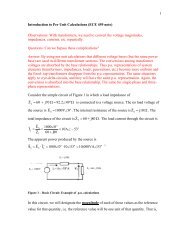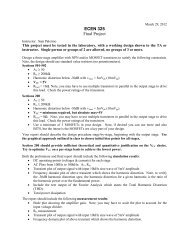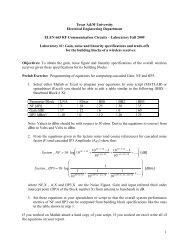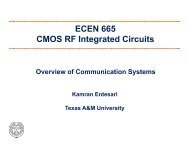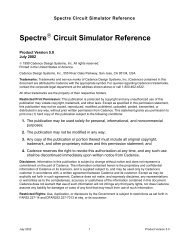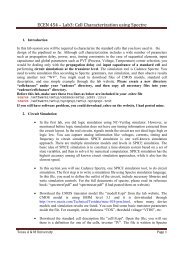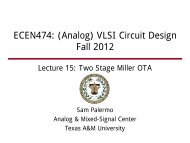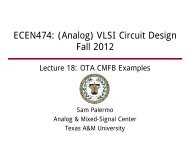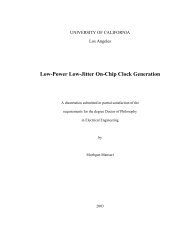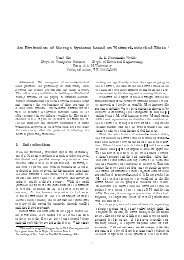Solutions 2
Solutions 2
Solutions 2
Create successful ePaper yourself
Turn your PDF publications into a flip-book with our unique Google optimized e-Paper software.
ECEN 619 - HW#2: Please answer the following questions:<br />
Due on Feb 19, 2013, in class. (No late homework accepted)<br />
1) Give 3 examples of network attacks.<br />
Spam, denial of service attacks, viruses.<br />
2) What is HTTP protocol and which layer does HTTP sit at?<br />
HTTP is Hypertext Transfer Protocol<br />
HTTP assumes messages can be exchanged directly between HTTP client and<br />
HTTP server<br />
In fact, HTTP client and server are processes running in two different<br />
machines across the internet.<br />
HTTP uses the reliable stream transfer service provided by TCP<br />
HTTP builds on top of TCP<br />
HTTP protocol sits at application layer.<br />
3) What is DNS protocol and which layer does DNS sit at?<br />
DNS is Domain Name System protocol<br />
DNS protocol allows queries of different types<br />
(1) Name-to-address or Address-to-name<br />
(2) Mail exchange<br />
DNS usually involves short messages and so uses service provided by UDP<br />
DNS builds in top of UDP<br />
DNS protocol sits at application layer.<br />
4) What is UDP protocol and which layer does UDP sit at?<br />
UDP is User Datagram Protocol<br />
UDP provides best-effort datagram service between two processes in two<br />
computers across the internet<br />
Port numbers distinguish various processes in the same machine<br />
UDP is connectionless<br />
Datagram is sent immediately when data is ready<br />
Quick, simple, but not reliable<br />
TCP builds on top of IP<br />
UDP protocol sits at transport layer.<br />
5) Describe the differences between the connection-oriented transport protocol and<br />
connectionless transport protocol.
(1) The connection-oriented transport protocol specifies that the connection need to<br />
be established before data can be exchanged, which cause the data can arrive in<br />
order. It guarantees delivery successfully by sending ACK. An example for the<br />
connection-oriented is TCP.<br />
(2) The connectionless transport protocol states different from the connectionoriented<br />
protocol. The delivery is not reliable. An example sor the connectionless<br />
transport protocol is UDP.<br />
6) Describe the differences between the packet-switching networks and circuitswitching<br />
networks.<br />
(1) In circuit switching networks, the data transmission path is dedicated to an entire<br />
data block, which implies that there no other data transmission can share the same<br />
channel. The channel can only be used by others when the current data has been<br />
finished transmitted.<br />
(2) In packet switching networks, the data is partitioned into a number of data units<br />
(packets) with their own sequence number. These data packets are sent through<br />
different channels in different times, but they will be reassembled in the original<br />
order at receiver.<br />
7) Describe the TCP Tahoe and TCP Reno algorithm, respectively.<br />
TCP-tahoe (Jacobson, 1988)<br />
- Time-out based protocol –use timeout to detect packet loss and<br />
congestions<br />
- Protocol:<br />
i. After every acknowledgement of a new packet:<br />
If W
ii.<br />
iii.<br />
when the duplicate acknowledgement exceeds a threshold, retransmit<br />
“next expected” packet:<br />
set W t =W/2, then set W= W t (i.e. halve the window);<br />
resume congestion avoidance using new window once retransmission<br />
is acknowledged.<br />
Upon timer expiry, the algorithm goes into slow start as before:<br />
Set W t =W/2;<br />
Set W=1<br />
8) What are the major differences between TCP Tahoe and TCP Reno?<br />
TCP Reno introduces fast retransmissions and fast recovery. TCP Reno uses triple<br />
duplicate ACKs to the same sequence number. The missing segment is retransmitted<br />
immediately<br />
9) Describe the principle of “Self-clocking” of TCP protocol.<br />
Packets after the first burst are sent only in response to an ACK, the sender’s packet<br />
spacing will exactly match the packet time on the slowest link in the path. Since the<br />
packet transmission is dominated by ACK, self-clocking is achieved<br />
Sender sends packets back-to-back to receiver<br />
The vertical line is bandwidth<br />
The horizontal line is time<br />
Each of shaded box is a packet<br />
Bandwidth*Time = Bits, and so the area of each box is the packet size.<br />
The number of bits doesn’t change as a packet goes through the network so a<br />
packet squeezed into the smaller long-haul bandwidth must spread out in time.<br />
The time P b represents the minimum packet spacing on the slowest link in the<br />
path (the bottleneck)<br />
As the packets leave the bottleneck for the destination net, nothing changes<br />
the inter packet interval so on the receiver’s net packet spacing P r = P b .<br />
If the receiver processing time is the same for all packets, the spacing<br />
between ACKs on the receiver’s net A r = P r = P b<br />
10) What are the major factors to determine the "timeout" clock value?<br />
The Round Trip Time (RTT)<br />
11) Why is it difficult to design the "timeout" clock value for TCP in Internet?<br />
The timeout value needs to be longer than RTT, which varies randomly. If the<br />
timeout value set too short, then there will have unnecessary retransmissions. If the<br />
timeout value is set too long, then TCP alright waste time to wait for the lost packet.<br />
12) Is there the optimal value for "timeout" clock for TCP in Internet?<br />
Non.
13) During which phase does TCP loose throughput most significantly?<br />
Slow start phase.<br />
14) Why does TCP Reno outperform TCP Tahoe?<br />
Because when three duplicate ACKs are received, TCP Reno will have a congestion<br />
window and set the slow start equal to the congestion window. Basing on this<br />
technique, TCP Reno can do fast retransmission.<br />
TCP Reno can retransmit the data faster than TCP Tahoe when the three duplicate<br />
ACKs have been received. Because when the above situation occurs, TCP Reno will<br />
skip the slow start phase and enter the congestion avoidance phase, unlike TCP<br />
Tahoe that has to start from slow start phase with window size equal to 1.<br />
15) Describe the "triple-duplicate ACK" control mechanism in TCP-Reno.<br />
If triple-duplicate-ACK with same sequence number has been received. TCP starts<br />
the congestion avoidance, which is set the congestion window size to half instead of<br />
one with window size in slow start phase. After triple-duplicate-ACK has been<br />
received, TCP Reno will start fast retransmission and fast recovery.<br />
16) When will the "fast retransmissions and fast recovery" control action be kicked in?<br />
When triple-duplicate-ACK with same sequence number has been received, fast<br />
retransmission and fast recovery starts.<br />
17) Can TCP Reno solely rely on the "triple-duplicate ACK" control mechanism for<br />
flow control and why?<br />
No, because timeout must be used when there is severe congestion or connection is<br />
broken.<br />
18) Can TCP flow control totally eliminate packet losses and why?<br />
No, because TCP creates packet losses.<br />
19) Is the "Slow Start" really SLOW for TCP in Internet?<br />
No, because the slow start increases the congestion window exponentially, which is<br />
fast increase.<br />
20) What are the control laws for "Congestion Avoidance Phase" and "Slow Start Phase"<br />
for TCP?<br />
Congestion avoidance phase: linearly increasing congestion window (CWND)<br />
Slow-start phase: exponentially increasing congestion window size (CWND).





